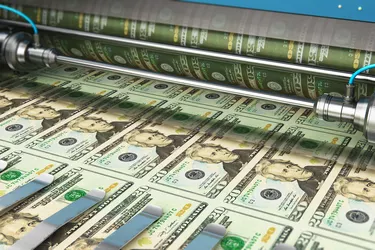
Although money is tangible, it represents some intangible benefits. You can hold money in your hand, but it's essentially worthless to you personally until you exchange it for something such as goods, services or even investments. And outside the myriad of creative ideas you can summon for the function of money, such as stuffing a pillowcase with dollar bills to make a pillow, money's economic function boils down to three primary concepts — a medium of exchange, a unit of account and a store of value.
Tip
Three function of money include acting as a medium of exchange, unit of account and store of value.
Video of the Day
What is Money?
Each country may assign a slightly different definition of money, but generally, it's defined as the legal tender medium of exchange that circulates within a country's borders. "Legal tender" simply means that money is a lawful (legal) payment that you offer (tender) to satisfy a financial obligation.
Video of the Day
Using this definition, bartered goods or services don't qualify as money, and credit cards also do not qualify. Cryptocurrencies are not recognized as legal tender in the <st1:country-region w:st="on">U.S., but Bitcoin is legal tender in some countries such as <st1:country-region w:st="on"><st1:place w:st="on">Japan.
3 Functions of Money
Economically, consumers depend on money for many reasons. Buying goods, paying for services, funding investments and saving for a rainy day are just a few of money's applications. But beyond the long list of its applications, the actual functions of money cover three general categories:
- Medium of Exchange. Arguably, the most important function of money is its value as a medium of exchange. Without money to serve this purpose, bartering from back in the day would likely make a comeback. But with a barter arrangement, you'd have to find, for example, someone who wanted the vegetables you grew in exchange for the eggs you wanted that their chickens produced. Money standardizes this equation to level the playing field for exchanges.
- Unit of Account. As the standard for weighing the worth of goods and services, money provides a common unit of account (or unit of value) in a country's economy. Essentially, money places a unit of value (a number) on the value of a commodity instead of a commodity placing value on another commodity, as in the bartering example. Even though the same item may be sold for different prices in different marketplaces, buyers and sellers alike can make informed decisions about their buying and selling.
- Store of Value. As a medium of exchange, money must be able to retain its value over time, which makes it a "store of value." There are other stores of value, such as land, collectibles and even patents, but these examples are not legal tender and, therefore, not classified as money. And even though money can depreciate because of inflation, it is typically more liquid than other stores of value, which means that it's readily accepted and easily transported.
Printing and Minting Money
The U.S. Treasury Department is responsible for printing paper currency and minting coins as it oversees the Bureau of Engraving and Printing and the U.S. Mint. Although the Federal Reserve Bank doesn't actually print and mint money, it does control the money supply by acting as the banker to the nation's banks. A bank that needs money requests it from the Federal Reserve Bank, which deposits the money into the bank's account, with interest. In turn, banks settle their accounts by returning the funds to the Federal Reserve Bank.